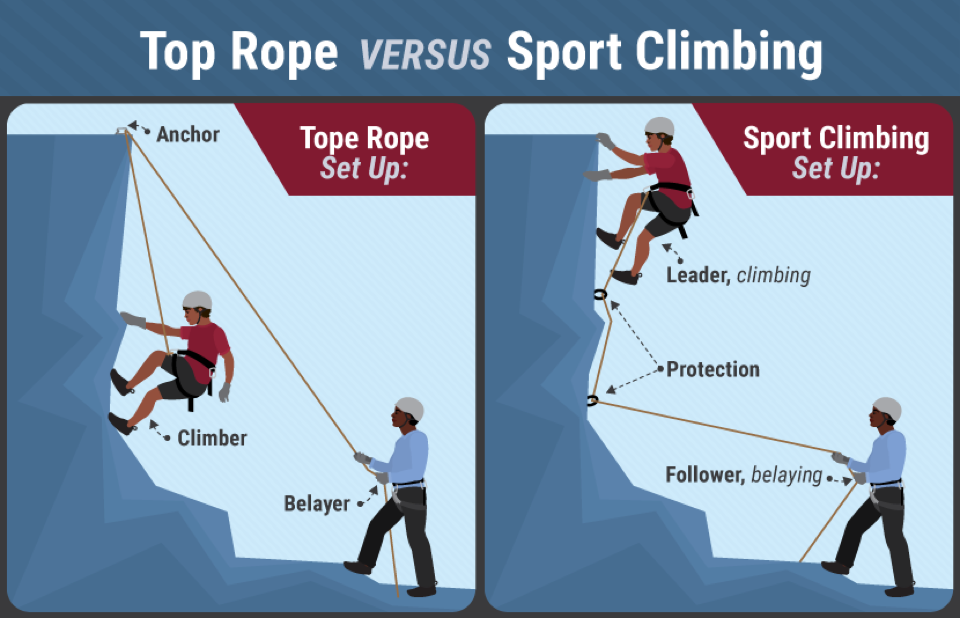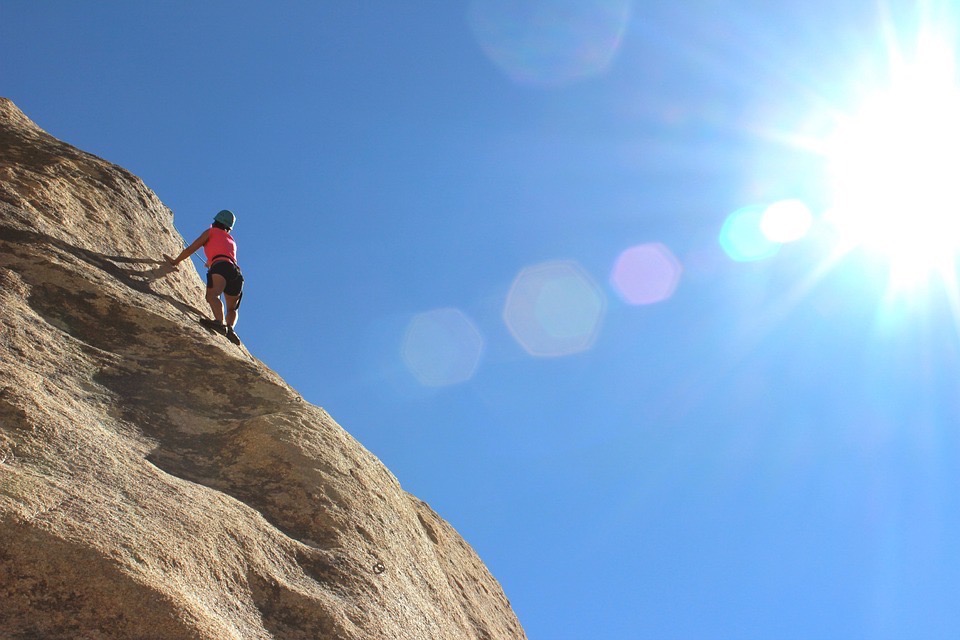Many people learn how to climb at a climbing gym, which is a great place to develop the basics. But there are some definite limitations to gym climbing, and moving to climbing outdoors opens up a whole world of new options and room for growth. Moving out of the climbing gym can be complicated – there are so many terms to learn and gear to master. This overview will get you ready to make the transition.

This is a common setup at climbing gyms. The rope is anchored at the top of the climb before the climber begins, which means that the only thing the climber has to do is climb. A belayer on the ground uses a belay device to take up slack in the rope as the climber moves upward. The belay device relies on friction to brake the rope and prevent the climber from falling very far if he or she comes off the wall. A fall will generally be anywhere from a few inches to one or two feet, as climbing ropes are designed to stretch a bit in order to help absorb the energy of a climber’s fall. Top-roping is very safe, and is a fun way to practice climbing movement on longer routes.
Bouldering is a type of climbing that is typically done on walls ranging from 10 to 15 feet in height, and is practiced without a rope, harness, or use of a belayer. However, boulderers usually have a crash pad – a thick mat that is placed below the route – and also often employ the use of a spotter to help land safely if they fall off the climb. Bouldering routes have a different rating from other climbs because the goal is to figure out the exact sequence of moves to “solve” the bouldering “problem.”

Sport climbing is a good next step for a gym climber because it adds a new element, but isn’t as complicated as traditional climbing. Climbing sport means you’re climbing a pitch that has bolts drilled along the entire route, including two bolts for anchor-building at the top. Sport routes are common in areas with rock that traditional gear would not fit in. Usually the bolts are metal and are placed in sections where the lead climber can place a quickdraw – a set of two carabiners connected by a length of sewn runner. The top of the draw is placed in the bolt and the bottom of the draw is clipped into the rope. This way, at each bolt, the lead climber has shortened the length of a possible fall.
When “leading” a sport route, the climber, belayer, and all of the rope start on the ground. As the leader moves up the route, she clips the rope to the bolts via the quickdraws. When the climber is below the clipped quickdraw, it is as though she is top-roping, with the rope running from the belayer, through the ‘draw, and then back down to her harness. However, as she moves up the climb to the next bolt, and climbs above her last clipped ‘draw, she has the potential to take a larger fall than she would while top-roping. In the event of a fall while leading on sport, the climber would fall to the last clipped quickdraw, then the same distance below it, and often a bit more to account for rope stretch. Sport climbing is still very safe; however, it has the potential for larger falls for those leading the routes.

Trad climbing is sometimes viewed as the most pure form of climbing because the lead climber places their protection as they go, which is more technical than clipping bolts in sport climbing. Trad climbing gets its name through being the original type of climbing, practiced in the ’50s, ’60s, and ’70s, before the advent of bolted climbs in the 1980s.
When trad climbing, the “protection” is a piece of gear that can be slipped into cracks or constrictions that the rope is clipped through in the same way that a leader climber clips a bolt when sport climbing. However, on a trad climb there are no bolts, and the protections can be removed after the leader has ascended to the top of the route. Trad climbing requires a lot of gear, and a lot of training in how to properly place the gear in the rock so that it will hold in the event of a lead fall.
It’s recommended for aspiring trad climbers to find a person or organization to get training and mentorship from in the art of placing gear prior to leading any trad climbs. A great way to develop this skill is through practicing placing gear on cracks and constrictions while on the ground, coupled with feedback and advice from a mentor.
Read more #FridayFix here.
The Women's Outdoor News, aka The WON, features news, reviews and stories about women who are shooting, hunting, fishing and actively engaging in outdoor adventure. This publication is for women, by women. View all posts by The WON